The annual Origins conference is one of the highlights of our summer. Every year, creationist scholars gather to present cutting-edge scientific research. Our New Creation team first attended Origins back in 2021. The conference has grown quite a bit since then, and more students attend every year! It is always good catching up with old friends and seeing the progress they’ve made. Origins features a diverse set of talks from the Creation Biology, Geology, and Theology Societies.

Origins 2025 took place in Dayton, Tennessee to commemorate the anniversary of the Scopes “Monkey” Trial. One hundred years ago, John Scopes was tried for teaching evolution in a public school. This trial began to shape public sentiment in support of evolution. Members of our team attended several commemorative events at the historic courthouse. These included various speeches from historians, creationists, and evolutionists. The annual play reenacting the Scopes Trial drew the largest crowds. Hundreds of people packed into the courtroom to see the showdown between Clarence Darrow and William Jennings Bryan.
Origins 2025 began on Sunday evening with an opening talk by Dr. Randy Guliuzza, president of the Institute for Creation Research (ICR). The conference was appropriately themed, “A Century of Creation”. Dr. Guliuzza challenged attendees to imagine what the next one hundred years of creationism might look like. Over the next two days, we learned about insect kinds, creationist explanations for the pattern of life, and fossil beds in Missouri.

It was exciting to hear young scholars contribute to the development of creation models. These included two writers from New Creation. Jake Ramgren discussed modern-day examples of evolution and their implications for the post-Flood diversification of created kinds. Peter Brummel talked about his research on the Tower of Babel and hominin pelves. The Genesis Fund supported these speakers and other New Creation staff, allowing them to attend the event. (If you are interested in donating to or learning more about The Genesis Fund, please follow the link.)
Below, we’ve summarized some of the plenary talks, abstracts, and papers presented at Origins 2025.
Day 1: Sunday Evening
Randy Guliuzza: 100 Years of Creation: A Sneak Peek at Origins 2125
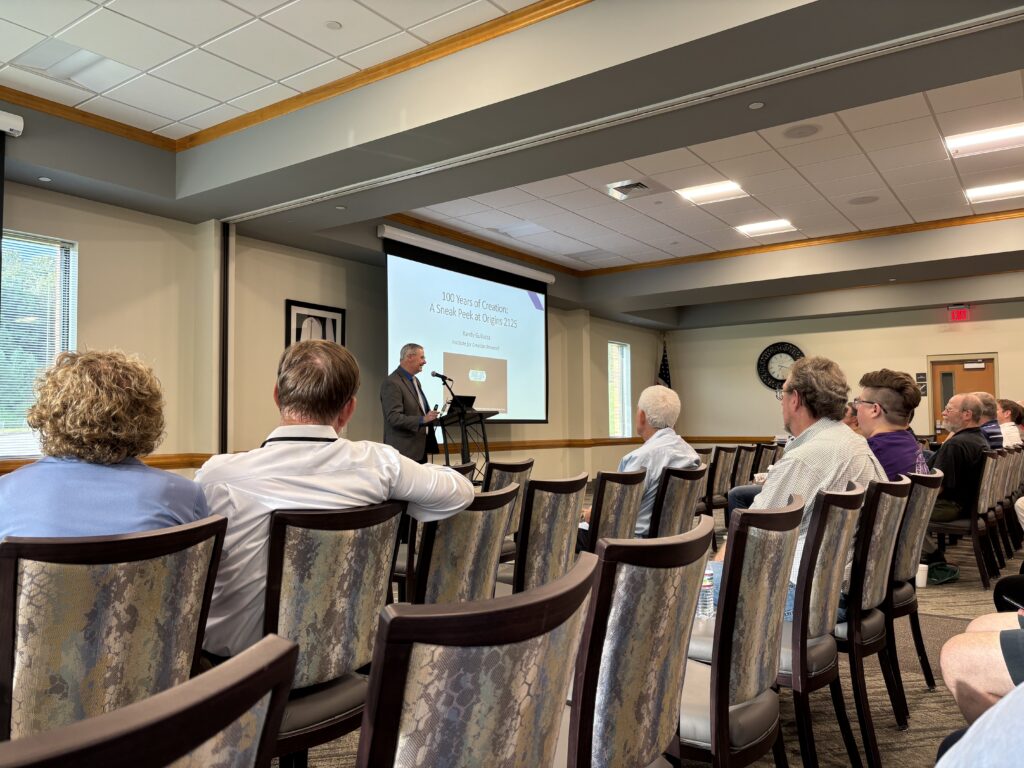
In his opening presentation, Dr. Randy Guliuzza, asked: “What would you do with a five-million-dollar research grant?” He argued that this money would be best spent on research questions that are specific and theory-driven. Creationists cannot be content critiquing evolutionary claims. Instead, we need to advance our own model by developing biblically based theories. These theories should answer big picture questions while providing a framework in which we can also pursue more specific research questions.
ICR is currently implementing this approach in its research on biological adaptation. Any theory of biological origins must answer the question: “Why do organisms look so highly-engineered to fill their particular environments?” ICR’s answer is that organisms have innate sensors that allow them to track environmental change and rapidly adapt. Researchers often refer to this hypothesis as CET (Continuous Environmental Tracking).
ICR scientists are currently testing CET through original, experimental research on blind cave fish. These blind, unpigmented fish have adapted well to subterranean life. ICR’s results thus far suggest that the selection of random genetic changes did not cause these adaptations. Instead, the cause of adaptation appears to be internal to the animal itself, consistent with the predictions of CET.1
Dr. Guliuzza also expressed his hope that in the future, creationists will do research not only for the sake of the creation-evolution debate, but simply to know Jesus—our Creator—and His works better through our study of creation.
He encouraged us to participate in creation science in light of our identity as new creations in Christ. We should regularly cite our colleagues, admit our mistakes, and share our new findings with each other. With this vision set for Origins 2125, the next century of creation looks very bright!
Day 2: Monday
Chad Arment: Terrestrial Arthropods on the Ark? A Biostratigraphic Perspective
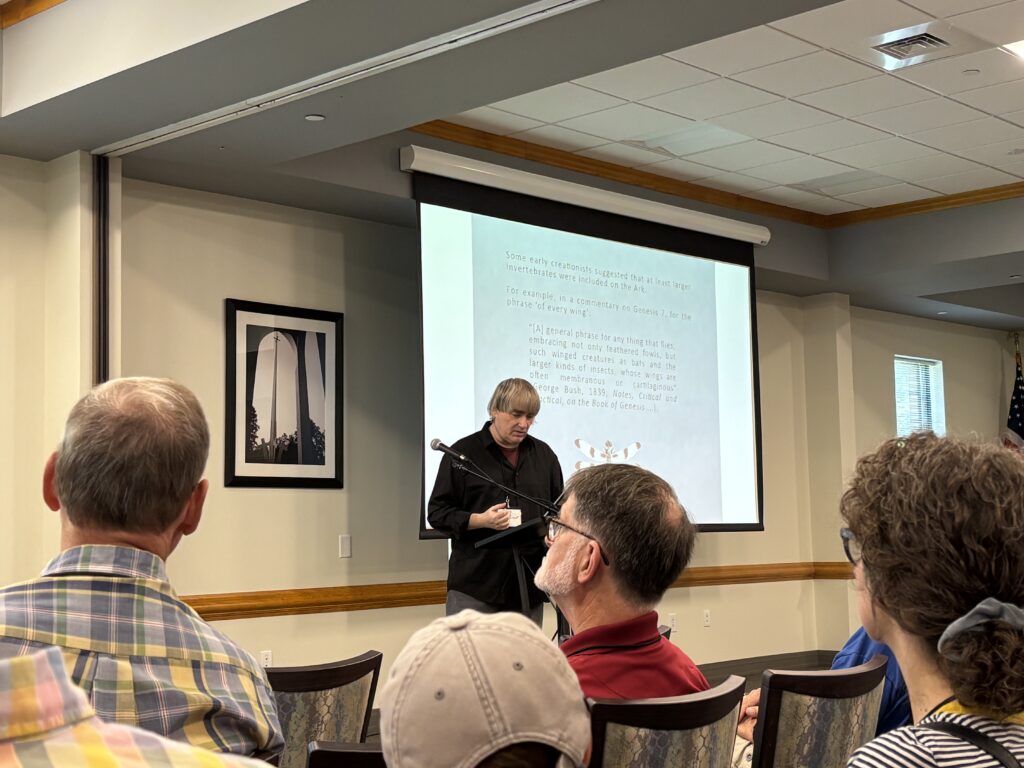
Were insects aboard the Ark? The Bible says that every creeping and flying thing, as well as every beast, survived Noah’s flood aboard the Ark. However, it is unclear whether insects are included under the category of “creeping thing”. Chad Arment attempted to answer this question by turning to biostratigraphy.
Arment suggested that insects and other arthropods (joint-legged animals including spiders, ticks, and crustaceans) survived outside of the ark based on their fossil record. He utilized an insect database and considered 2,862 arthropod families. He assumed a lower Cenozoic Flood boundary and corresponded the taxonomic level of “family” to a created kind (a trend among vertebrates, but still an assumption for insects since our sample size is so small). Armed with these two assumptions, he evaluated whether these arthropod groups crossed the Flood boundary.
If they survived the Flood outside of the Ark, then we would expect to see multiple types of arthropods within each kind/family crossing the boundary. If insects survived on the Ark, then the Flood would have narrowed all insects into two of each kind. This means we would observe only taxonomic families of arthropods when the Cenozoic (post-Flood) layer begins. His sample size included ticks, mites, millipedes, cockroaches, beetles, flies, true bugs, bees, ants, and net-winged insects. Out of the 2,862 arthropod families evaluated, 52 showed multiple taxonomic groups—more specific than family level—crossing the K/Pg boundary. If the arthropods were on the Ark and all other arthropod life perished, then only one pair of each family would have survived to populate the post-Flood world.
Since you cannot have multiple taxonomic groups with only two living representatives, the most reasonable conclusion is that insects survived the Flood outside the Ark, probably by eggs laid in floating tree mats or underground.
Kurt Wise & Matt McLain: Common Development as a Synthetic Theory of Creation Biology
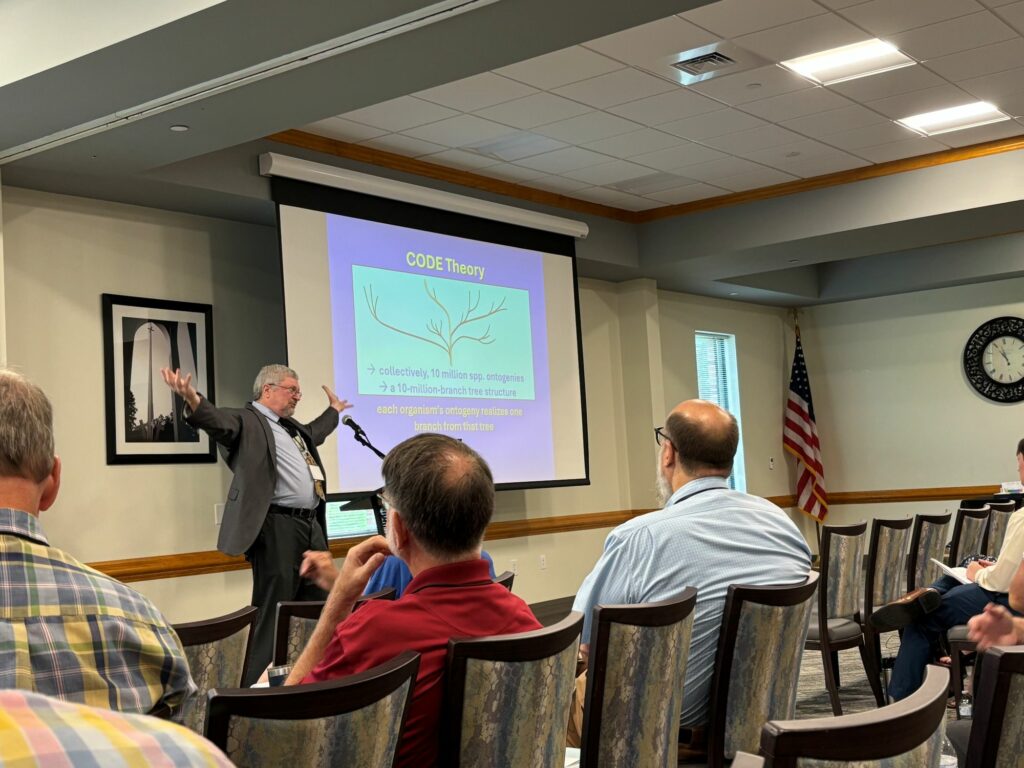
One of the long-standing advantages of the mainstream theory of evolution is its consilience. Many different lines of evidence converge in support of evolution. These include similarities between organisms in both embryo and adult forms, vestigial structures, fossil sequences bridging gaps between groups of organisms, and the fact that we can consistently classify organisms into a single nested hierarchy resembling a family tree. A creationist theory of biology requires an explanation for the overall pattern of life, not just answers to individual evolutionary challenges. Creationists need a unifying theory of biology. Paleontologist Dr. Kurt Wise proposed one in the form of a new model-in-development he is calling CODE Theory. CODE stands for COmmon DEvelopment.
In a nutshell, he proposes that the reason all animals can be categorized into a single, nested hierarchy is because they all share the potential to develop from a single cell into all the variety of forms we actually see in nature.
During embryonic development, animals pass through different stages with increasing levels of complexity. For example, most animals begin as a hollow ball of tissue called a blastula, which folds on itself to form the gut cavity (a process called gastrulation). At this point, different embryonic tissue layers form, each having different destinies as development progresses. We see this same process whether we are looking at the embryos of starfish, cuttlefish, lungfish, or jellyfish.
Now let’s imagine the process of animal development as a pathway with a multitude of branch points giving rise to new pathways. These pathways lead to a practically endless number of animal forms. These developmental outcomes are not random, but brought about by the unfathomably complex, well-designed biological mechanisms that control development.
According to CODE theory, the reason animals show similarities in both their embryo and adult forms is that they share portions of their developmental pathways. The reason some animals have vestigial structures is because they pass through the same developmental stage as animals wherein those structures are fully-functional or serve a different function. For example, whales have a tiny pelvis because they follow the same developmental pathway as land mammals.
CODE theory can also explain intermediate fossils. For example, the extinct “mammal-like reptiles” are “mammal-like” because they share part of the same developmental pathway as living mammals. While living mammals travel fully down the “mammal path,” the different groups of “mammal-like reptiles” stopped and diverged at different points along the path. This is why many of the “mammal-like reptiles” in some ways resemble the embryonic stages of living mammals, while being fully-functioning adult animals.
Within CODE theory, creationists can easily explain why animals fall into a nested hierarchy of groups within groups. This is because all animals share differing amounts of the same developmental super-pathway. Groups of animals that share more of the pathway will be classified within the same genus, for example, while multiple groups all diverging from the same part of the pathway might be classified within a family or order.
As you can see from these examples, CODE theory has a lot going for it! Dr. Wise believes that it can explain many aspects of biology that evolution either struggles with or doesn’t attempt to explain. This model is still very new, so it required further refinement and collaboration with other scientists. However, if even just parts of this model are correct, it could be a big step forward in creating a “theory of creation.”
Kurt Wise: Creation Illustrations of Divine Nature Extended from Biology to the Physical Sciences
In 2018, Dr. Wise published a textbook called Devotional Biology, which teaches biology starting with the attributes of God. The idea for this comes from Romans 1:20: “since the creation of the world [God’s] invisible attributes… have been clearly seen, being understood through what has been made.” Dr. Wise reasons that if God reveals Himself through His creation, then we can study the creation by starting with how God has revealed Himself in Scripture. In this presentation, he outlined three ways in which we can extend this approach to the physical (or non-biological) sciences.
First, the physical sciences highlight the lack of a natural mechanism for various features in biology (origin of life, personality, et cetera) that point to a Creator. Second, the physical sciences extend illustrations of God’s nature from biology to the rest of the universe. Examples of this include beauty, which illustrates God’s glory, and language (mathematics, the language of the physical sciences), which reveals God as a Communicator. Third, the physical sciences can illustrate attributes of God which are not as readily seen in biology. For example, the invariant nature of the laws of physics reflects God’s unvarying character.
When you start with God’s attributes and look for illustrations of them in the creation, you find examples of phenomena that not only reflect God’s character, but are also very difficult (if not impossible) to explain by naturalistic means. As the apostle Paul said, those who reject God are indeed “without excuse.”
Peter Brummel: Is Eridu the Biblical Babel?
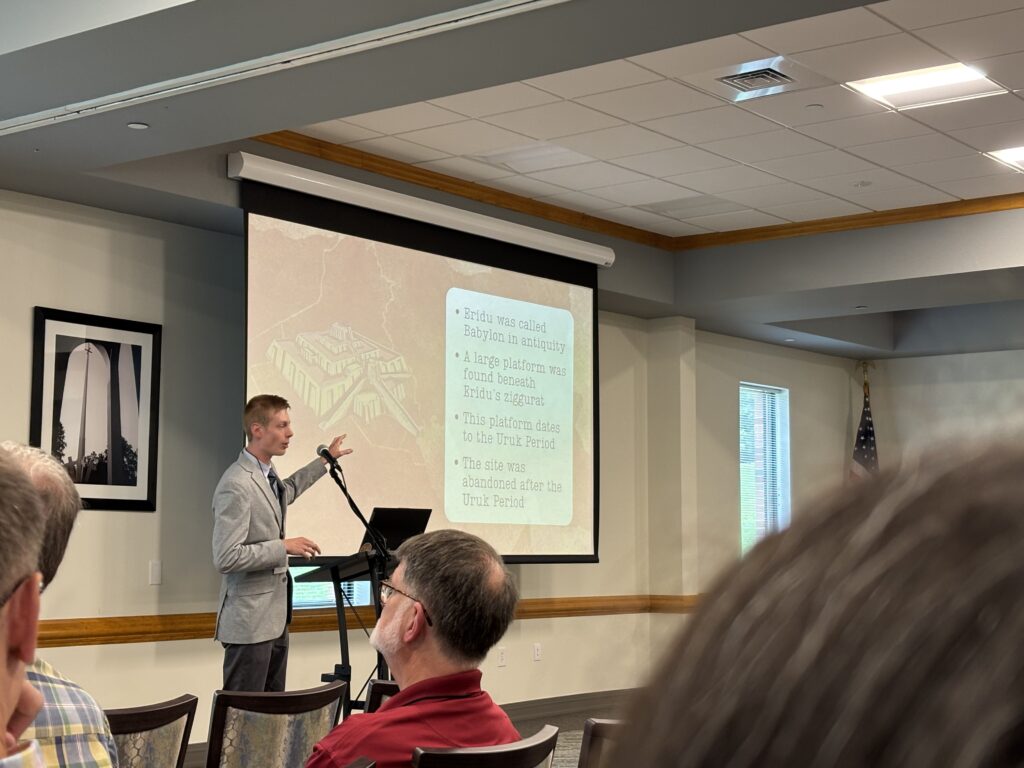
Where was the Tower of Babel built? And at what point in the post-flood history of humanity did Babel take place? These are the questions that Peter Brummel discussed in a refutation of Dr. Douglas Petrovitch’s views on historical Babel.
There are two prevailing views on the timing of the Babel dispersion. Dr. Petrovich suggests that the Babel dispersion took place some time after Noah’s family disembarked from the Ark. By this time, humanity had already dispersed over the earth. Petrovich argues that only a small group of Mesopotamians were involved in building Babel. Brummel rejected this view in favor of the more traditional model in which the Babel dispersion took place shortly after the Flood. In this view, all of humanity was involved in the building of Babel, and the Babel dispersion was the driving force that sent humans out across the earth.
Brummel argued that the Hebrew text in Genesis 11:1–2 supports his view. This is because the Hebrew phrase col ha-eretz, often translated as “all the earth” functions as the antecedent of the pronoun referring to the builders of Babel. Col-ha-eretz appears again in Genesis 1:8–9, this time referring to those whose languages God confused. This demonstrates that the narrative is continuous. The whole earth spoke the same language, migrated to Shinar, and dispersed from Babel.
Next, Brummel turned to the archaeology of Eridu, the site which Dr. Petrovich argues is the best candidate for Babel. Petrovich describes a large unfinished platform at the site of Eridu as the base of the Tower of Babel. Brummel noted that the builders made this platform from stone, not the burnt brick described in Genesis. Construction of religious architecture may have continued into the subsequent archaeological period. This indicates Eridu may not have been abandoned at the end of the Uruk period. He concluded that Eridu is probably not the site of the biblical Babel. Genesis 11:1–9 describes a universal event, not a local dispersion. Brummel’s conclusion is that archaeological reports describing the city of Eridu do not support Petrovich’s claims.
Dustin Burlet: Flat Earth Fallacies
We know the Bible is true. It presents more than just mythology; it provides True Truth. But, is it possible to take the Bible too literally? Dr. Dustin Burlet tackled this question and more as he refuted flat-earth ideas about the cosmos.
Our limited perception, Dr. Burlet noted, has widened with the advent of microscopes, telescopes, and space travel. But, despite Jesus looking upward to pray (John 17:1) and Paul instructing his readers to fix their minds on things above (Colossians 3:1), when we look upward, even with the most advanced telescope, we do not see Christ seated on God’s right hand (Ephesians 1:20). And even though Genesis 1 seems to describe a physical structure above the earth, Jesus didn’t bump his head when he ascended into heaven! Therefore, even though we believe the Bible is true when it indicates that heaven is up, we recognize that it is up in a different sense than what we can see through a telescope.
Dr. Burlet argued that in the same way, Ancient Near Eastern portrayals of the cosmos as a glass-like solid surface do not necessarily provide an accurate picture of the way that the people of those cultures viewed the cosmos. The way Ancient Near Eastern people depicted the cosmos was not necessarily the way they viewed the cosmos.
Dr. Burlet concluded that the biblical descriptions of the universe represent a divine accommodation to human fitness. This is akin to telling a child that he came from Mommy’s tummy. Biblical language can be symbolic, and scripture communicates truth expressed in a way its readers can understand.
Marcus Ross & Dustin Burlet: The Indominatables
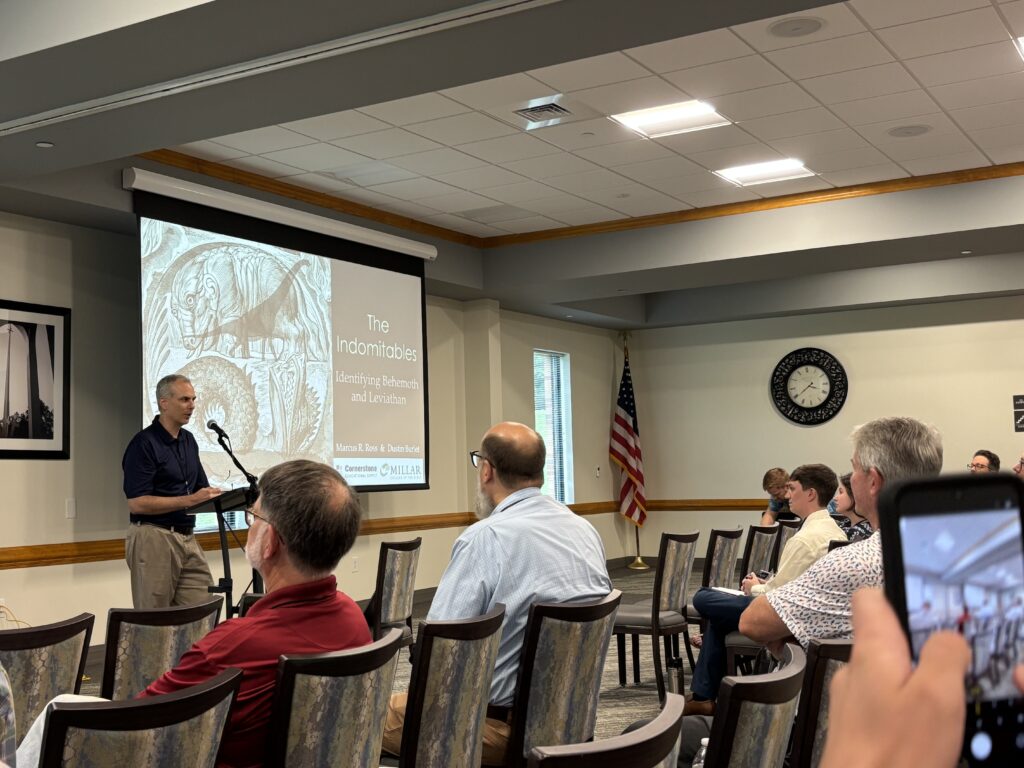
Young-earth creationists often consider Behemoth and Leviathan from Job 40 and 41 as examples of “prehistoric” reptiles (a long-necked sauropod dinosaur and a swimming reptile, respectively). However, paleontologist Dr. Marcus Ross presented significant problems for this understanding. He highlighted that, even among conservative Bible scholars, disagreement exists as to whether these creatures are actual flesh-and-blood animals, symbolic representations, or mythic creatures used to make a theological point.
Dr. Ross explored the pros and cons of interpreting the creatures as members of the animal kingdom. He then discussed the Ancient Near Eastern parallels to Behemoth and Leviathan. Explaining Leviathan’s connection with the Lotan, the sea serpent who represented the chaos of the deep, he suggested that Behemoth might be associated with the Bull of Heaven from Ancient Near Eastern mythology.
He concluded with a look at the context of God’s speech to Job. Whatever Behemoth and Leviathan represent, God’s point is that He is greater than they are. and that He rules the world through wisdom. You can learn more about Behemoth and Leviathan in this article.
Jeremy Blaschke: Creation Longs for Adoption
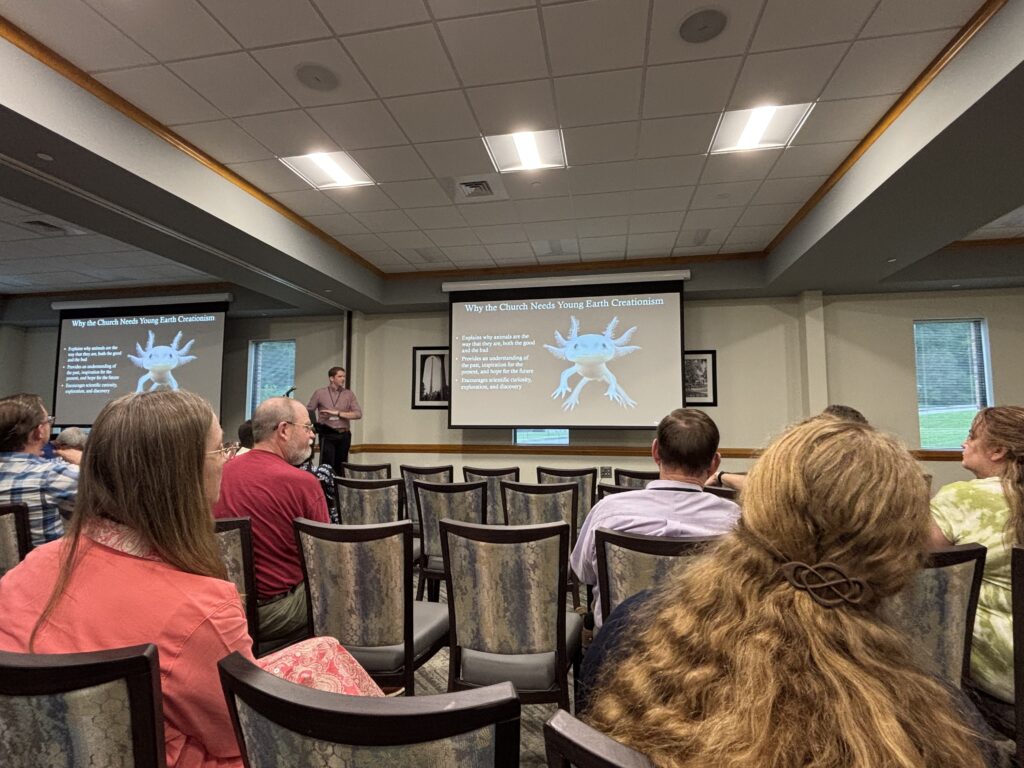
Romans 8:19 teaches that creation longs for the adoption of the sons and daughters of God. Animals are intrinsically linked to the relationship between humans and God, and they unconsciously yearn for the moment when people are reunited with their Creator. What does this mean? Jeremy Blaschke proposed that Young-earth Creationism provides the best answer to this question, along with the host of questions that come with it. Like many other philosophical challenges, people explain this question by telling stories. Throughout human history, stories have answered the big questions like “who are we?” and “where did we come from?” and “why are we here?”. Belief in an omnipotent, eternal, lawful, faithful, and creative God offers answers to these questions, but young-earth creationism specifically provides the best answer to the challenge above. Why does creation groan for a new world? Because creation is deeply broken, flawed, and corrupt.
This idea clashes with the old-earth story in which God designs creation the way it is, and called it “very good” (Genesis 1:31). Creation is filled with both incredible beauty and deeply disturbing ugliness. For example, leaf-cutter ants show incredible mutualism with caterpillars. The ants provide protection, the caterpillar provides food, and the two can communicate through noises generated by ridges on the caterpillar’s neck. The relationship, however, can take a dark turn. The wolf butterfly caterpillar releases chemicals that give the ants a dopamine hit, so the ants become addicted to feeding it, all while the caterpillar eats the ants’ larvae too. In another twist, tamarin parents sacrifice 20% of their body weight caring for their young, but if the father is killed by a predator, it is not uncommon for a mother tamarin to kill her offspring and eat its brain.
The horrific examples continue. Decapitating flies lay larvae in ant skulls and use the heads as incubation chambers. Sacculina—a parasitic barnacle—uses long stringy coils to control the minds of crabs, and manipulates them to do their will. Fork-tailed drongos (an African bird) imitates the alarm calls of other animals. Then the animals scurry for cover, the drongo steals their food. If a male sea otter cannot find a mate, it will hold a baby otter underwater until its mother consents to mate with him.
All of these horrifying stories reflect broken relationships: relationships between animals and God (species are not as God designed them to be), species and other species (creatures harming each other), animals and other animals (animals harming their own families). In young-earth creationism, God created these relationships whole, perfect, and beautiful. But after the fall of man, these relationships corrupted, and are not the way they were designed to be. In an old-earth view, there is no way around the fact that God designed nature with parasitism, infanticide, and corrupted relationships. But with young-earth creationism, we believe that in Scripture we find understanding in the past (Romans 8:19-22), inspiration for the present (Proverbs 12:10, Ephesians 1:5, 5:1-2), and hope for the future (Revelation 21:3-4). Young-earth creationism is a great story. And stories are better when they are true.
Day 3: Tuesday
Jaden Deweese and Matt McLain: Dipnoi: An Apobaramin Relative to Porolepiformes and Other Sarcopterygians
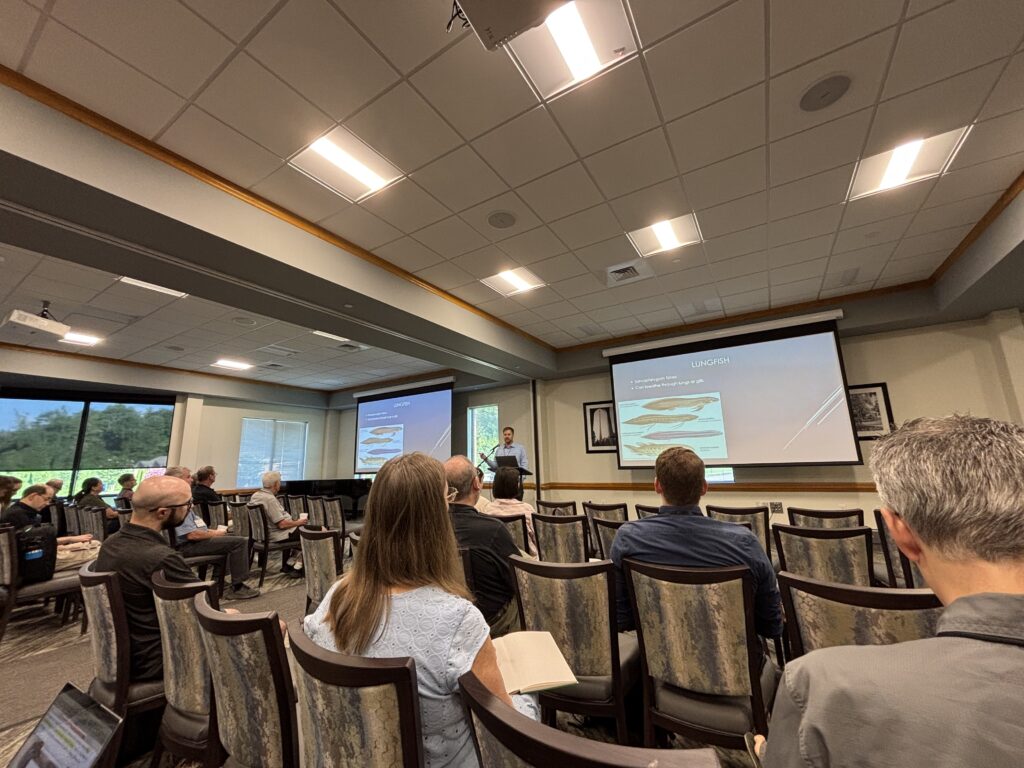
Dr. Matt McLain presented a baraminology study on living and fossil lungfishes (Class Dipnoi) led by student researcher Jaden DeWeese. Lungfish, as their name suggests, have lungs as well as gills, and can breathe out of water. Lungfish and coelacanths are the only living members of an eccentric group of fish known as the sarcopterygians (literally “flesh-fins”). Unlike most living fish, sarcopterygians have fins composed of a solid core of bone rather than individual bony rays.
Among living fish, there is nothing like the lungfish. Evolutionary paleontologists regard one group of extinct sarcopterygians, the Porolepiformes, as closely related to lungfish. However, in their baraminological analysis, DeWeese and McLain found that lungfish are very distinct from the porolepiforms. In baraminology, a group of organisms that is set apart from all other groups by discontinuity is called an apobarmin. Deweese and McLain also found evidence for there being at least two separate kinds within Dipnoi, though there could be as many as five.
Lungfish have an extensive fossil record that goes down to the lower Devonian, though only three families live today. According to Dr. McLain, researchers have found representatives of these three families below or near the Cretaceous/Paleogene boundary on the continents where they still currently residing. This suggests that the ancestors of today’s lungfish survived the Flood off the Ark, possibly in small pockets of freshwater that did not mix together with sea water.
Peter Brummel and Todd Wood: Progress Report on a Morphometric Analysis of Hominin Pelves
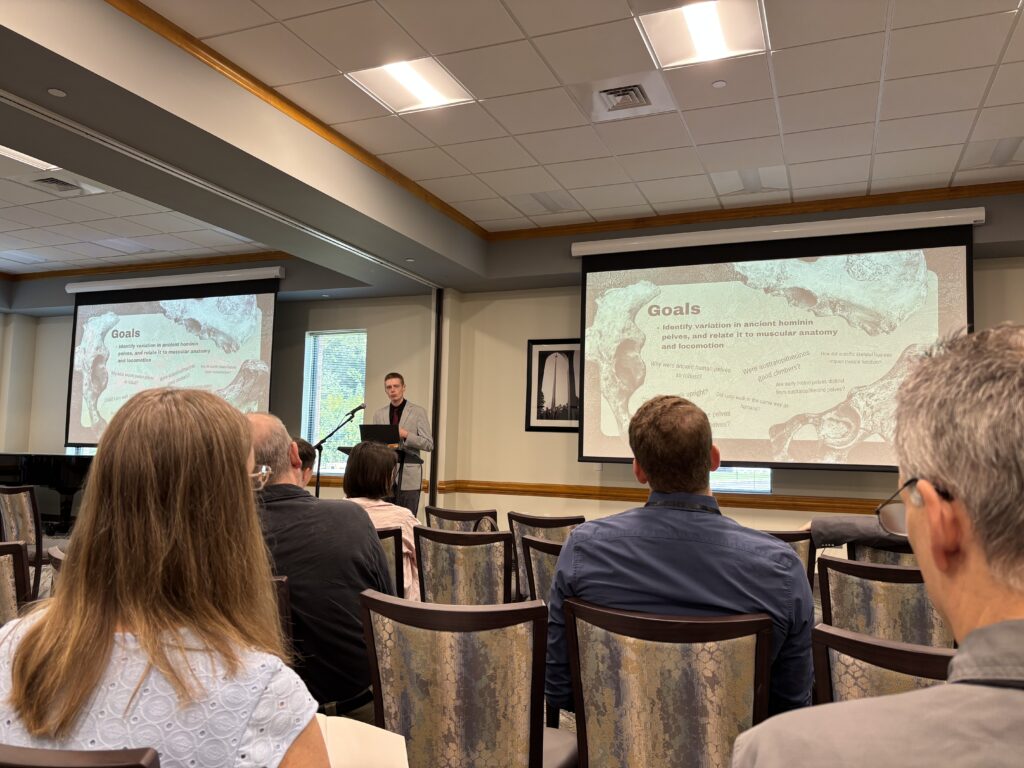
Brummel and Wood presented an update on their study of hominid pelves. The pelvis plays a fundamental role in walking and climbing. Careful study and measurement allows scientists to distinguish between animals with different lifestyles. Brummel and Wood took thirty-three linear and angular measurements of hominid pelves. They analyzed these measurements using a Principal Components Analysis. This analysis appeared to identify three separate functional groups: living apes, australopithecines, and humans.
A clustering analysis of this data found two clusters, one containing living great apes, and another containing living humans, fossil humans, and australopithecines. This indicates that the pelvic anatomy of australopithecines was more similar to that of humans than living apes. Brummel went on to discuss how particular anatomical features affected behavior. They concluded that australopithecines were habitually bipedal, but may also have spent some time climbing in the trees.
Kurt Wise and Neal Doran: Evidence in Sepkoski’s Marine Genera Data for Two Distinct Antediluvian Marine Biotas
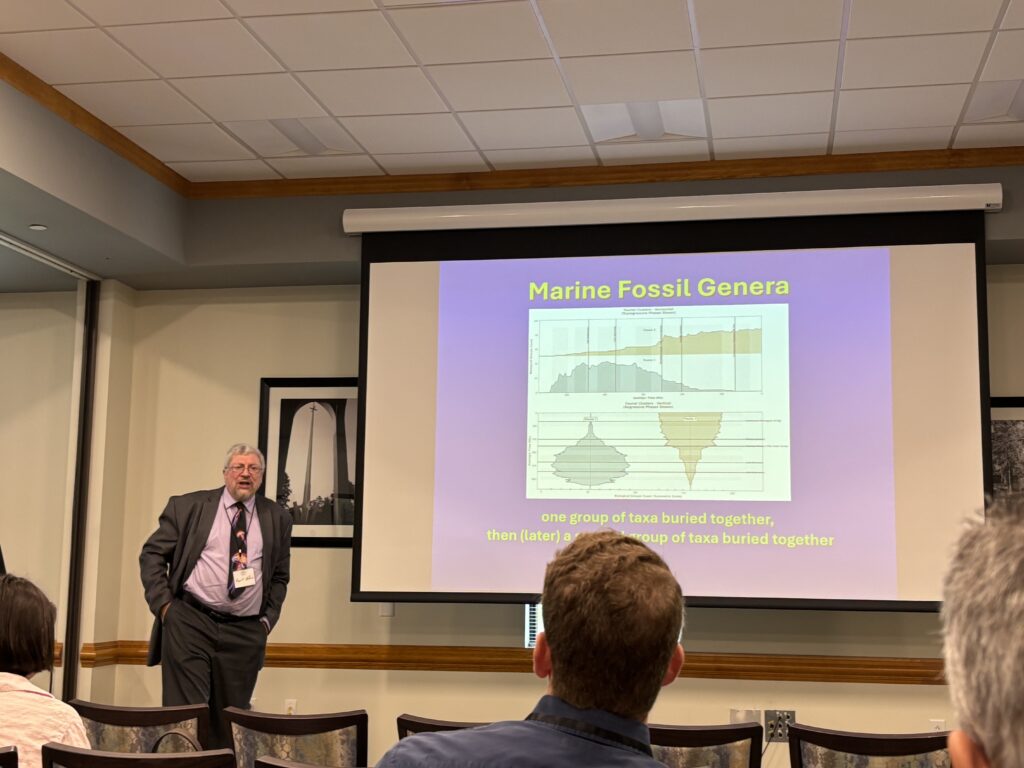
When you go to the beach, what kinds of seashells do you expect to find? Very likely, you expect to find bivalves (e.g., clams, scallops, and mussels) and gastropods (e.g., snails). But what if you could go back to the time before the Flood and collect seashells? What would you find on the beaches of Antediluvia?
Paleontologist Drs. Kurt Wise and Neal Doran suggest that the pre-Flood continent which humans inhabited was surrounded by shallow waters teeming with marine life that we now find in abundance in Paleozoic rock layers: brachiopods (lamp shells), trilobites, horn corals, and nautiloids (squid-like predators with chambered shells). Before the Flood, Drs. Wise and Doran suggest the marine creatures familiar to us lived in a completely separate sea. This shallow sea encircled a set of continents or a single supercontinent where the now-extinct dinosaurs ruled, while humans and “modern” mammals were absent.
Drs. Wise and Doran proposed this hypothesis because of the patterns they observed in the appearance and disappearance of marine invertebrates across successive geological “time bins”. They found that marine invertebrates occurred in two large clusters. The first group corresponds to Paleozoic marine invertebrates and the second to “modern” marine invertebrates, which first become prevalent in Mesozoic rocks. These groups likely represent real, complete ecological communities that inhabited shallow marine environments before the Flood. But how could two separate shallow marine realms exist before the Flood?
Drs. Wise and Doran’s tentative solution to this paradox is that these two marine realms surrounded separate continents or sets of continents. Paleozoic marine organisms lived on the continental shelves of the landmass inhabited by humans and “modern” mammals. After the Flood buried Paleozoic marine life, it then buried Mesozoic marine life, explaining why they occur in two separate clusters in the fossil record. Since we find no fossil evidence of humans or “modern” animals in either Paleozoic or Mesozoic rocks, these researchers suggest that the entire continent they lived on is now completely lost.
Is this a crazy idea? Yes, absolutely. But outrageous ideas in science can be useful if they lead us to ask new questions we would never have asked if we simply stuck to more “traditional” ways of thinking. As creationist model-builders, we should be open to “out of the box” ideas. And even if our first ideas turn out not to work, we can always refine them as they are challenged with new data, or abandon them for new ideas.
In this case, Drs. Wise and Doran showed how an old model of the Flood cannot readily account for certain data and proposed a change in that model that would account for it. This model itself will likely be refined (or entirely rejected) as time goes on—and that’s okay, because that’s the process of science!
Neal Doran: Fossils Tell Time: Machine Learning Test of Paleogeographic and Ecological Ordering
Dr. Neal Doran also shared how he used machine learning to predict the best factors for understanding the order of the fossil record. Machine learning (ML) is a sub-field of artificial intelligence (AI) that trains computers to recognize patterns in data and make predictions using those patterns. For example, if I fed an ML algorithm several weeks of data on Saturday morning traffic conditions in my area, it could make a prediction about the best time for leaving on a day trip. ML is able to “learn” by checking its predictions against known examples, improving its predictions by repeated cross-checking. So, what applications can ML have in creation science?
One application is to use it to refine our understanding of how the Flood formed the fossil record. Creation paleontologists often explain the order of the fossil record as a result of pre-Flood ecological zonation. In this model, the fossils found lower in the geological column (e.g., Cambrian rocks) came from ecological zones swept away earlier in the Flood than those found at higher levels (e.g., Cretaceous rocks). In contrast, the evolutionary model explains the order of the fossil record as due to evolutionary development over geological time, with organismal complexity increasing from the lower levels of the geological column to the higher levels.
Dr. Doran used ML to test which of these variables (ecological zonation vs. complexity) is the best predictor for the order of the fossil record. He also decided to include paleogeographical location as a variable. This is the location (latitude and longitude) of the fossil at the time of its burial.
Dr. Doran found that models based on ecological zonation and complexity were able to correctly predict where each fossil belonged in the geological column extremely well. The ecological zonation model actually outperformed the complexity model, which is encouraging for us as creationists! What was surprising to Dr. Doran, however, was that paleogeography actually performed the best of all three.
According to Dr. Doran, this means that while we normally think of time in paleontology in vertical terms (e.g., lower means older, higher means younger), we should also think of it spatially (e.g., over there means older, over here means younger). Paleogeography, then, appears to be an overlooked but important control on when things got buried during the Flood.
Ken Coulson: Contextualizing Genesis 1:31’s “Very Good”
Dr. Coulson argued in his presentation that the only adequate resolution to the problem of evil comes from the young-earth perspective: that death and suffering came into the world as the direct result of sin. In any old-earth perspective, death and suffering are an inevitable part of the process by which God created the universe. According to these views, most of the fossil record predates the creation and fall of man, which means that the entire record of death, disease, and suffering in the fossil record predates sin. This is difficult to reconcile with God’s pronouncement in Genesis 1:31, that what He had made was “very good.”
The key to this discussion is the meaning of “very good” in Genesis 1:31. What did God mean when He said that what He had made was “very good”? Often, old-earth theologians try to define “very good” in terms of later revelation in Scripture; for example, Romans 8:28, which says that God uses all things—including suffering—for good. Another example is the blind man in John 9, whom Jesus said was blind “so that the works of God might be manifested in him” (John 9:3). However, this doesn’t answer the question of why there is evil in the first place. Dr. Coulson argued that, as the saying goes, “context is king”. We should derive our definition of “very good” in Genesis 1:31 from Genesis 1 and 2, with the account of the Fall in Genesis 3 providing contrast to enhance that definition.
Zachary Klein: Ordovician Density Flow Complex
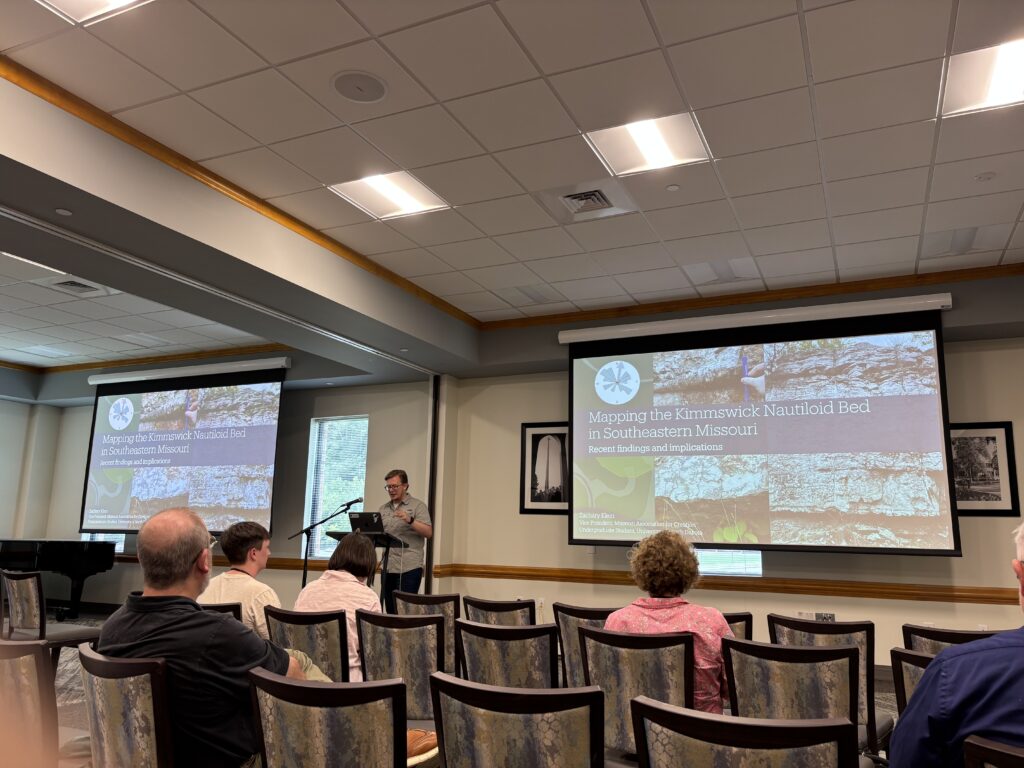
Many creationists are familiar with geologist Dr. Steve Austin’s work on the nautiloid bed in the Redwall Limestone, a Mississippian layer within the walls of the Grand Canyon. Nautiloids are octopus-like animals with ice cream cone-shaped shells. Billions of nautiloids are estimated to be preserved in this deposit which Dr. Austin thinks resulted from a debris flow, a kind of underwater landslide (but much bigger!). Creation researcher Zachary Klein presented another site that may showcase a second debris flow-caused nautiloid bed, this time in Missouri.
This site has no connection to Dr. Austin’s nautiloid bed in the Grand Canyon. This one is from the Ordovician (not the Mississippian) Kimmswick Formation near St. Louis, Missouri. It consists mostly of gray, cross-bedded limestone (cross-beds are inclined layers within the bed itself). The particular bed is three feet thick. Klein has realized that the bed has coarse grains and fossils which congregate toward the middle of the bed, making it more susceptible to erosion.
Above the Kimmswick Nautiloid Bed, Klein has also identified a five-layer sequence of rock layers. While he is not yet sure what this sequence is, he suspects it is a sequence of layers formed by tidal processes called rhythmites. There are also alternating chert and limestone beds above the nautiloid bed. And there is a layer of k-bentonite at the very bottom of the deposit. Klein believes this nautiloid bed formed from another massive debris flow. This provides another exciting opportunity for the influence of large scale catastrophes in the geologic record.
This site was one of the locations of the geology workshop at the Creation Research Conference later in the week. So stay tuned when I (Christian Ryan) discuss what it was like looking for nautiloid fossils in a roadcut just outside of St. Louis, Missouri!
Steve Austin: Ammonite Mass Kill Event, Lower Jurassic Limestone, Southeastern France
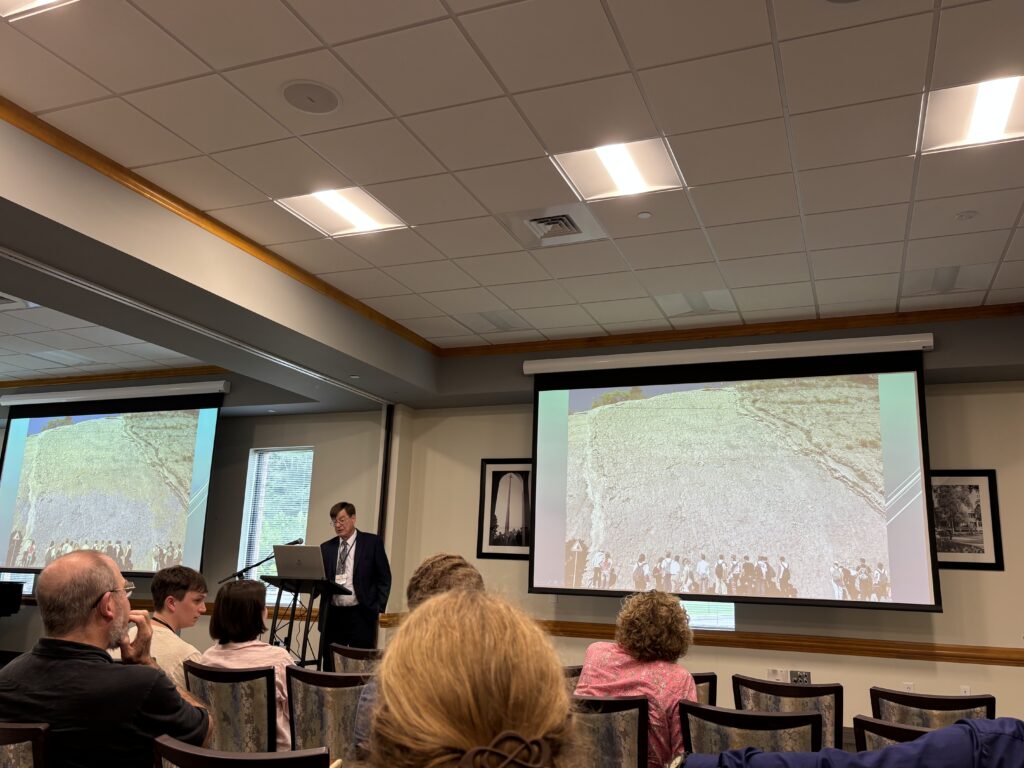
North of the town of Digne-les-Bains in southeastern France, road construction workers in 1941 uncovered a massive slab of Jurassic limestone covered in a layer of more than 1,500 ammonite fossils. It is known today as Dalles aux Ammonites (“Ammonite Slab”) and is protected as part of a UNESCO Geopark. Signs at the park suggest the ammonite layer accumulated over 100,000 years. This scenario is highly unlikely given what we know about how shells decay in the modern world. So, how would a young-age creationist geologist interpret this deposit?
Creation geologist Dr. Steve Austin had the opportunity to see and photograph the Ammonite Slab in person. Based on his observations, he developed a hypothesis to explain how it formed. Based on the size distribution of the shells, he suggests they represent an entire population of ammonites killed all at once. Afterwards, a single underwater debris flow swept away the carcasses. As the debris flow slowed down, very coarse lime sediment deposited first, then finer sediment. Lastly, the ammonites deposited at the top of the bed. The apparently non-random orientation of the coiled shells suggests that a current caused them to orient together.
This explanation of the Ammonite Slab is consistent with the data we have and it fits well with a Flood model for the deposition of Jurassic strata globally. But more work still needs to be done. Dr. Austin said he would like to visit the slab again in the future, so stay tuned for updates!
Day 4: Wednesday
Field Trip: Tour of Rhea County Courthouse
On the last day of Origins, I (Joshua Cedar) had the opportunity to tour the historic Rhea County Courthouse with the remaining conference attendees. Our guide was none other than Dr. Todd Wood, the president of Core Academy of Science in Dayton. Our first stop on the tour was the courthouse basement, which now houses a Scopes Trial Museum. We saw artifacts from the trial, such as the clerk’s typewriter, a press pass signed by all the major figures in the case, and a sock monkey toy like the ones sold by vendors at the trial in 1925.
Dr. Wood then took us to the second story to see the newly-restored courtroom. To our delight, we could stand or sit almost anywhere we wanted, including behind the judge’s desk! After we finished touring the court room, we headed down to the courthouse lawn. This was the stage for the most famous scene of the Scopes Trial, when Darrow questioned Bryan on the witness stand. Opposing statues of Bryan and Darrow on the courthouse lawn now memorialize the conflict for generations to come.
It’s incredible to think that one hundred years ago, a media frenzy caused all the world’s attention to focus on what took place in that old, red-brick building. Today, the quiet streets of Dayton provide a serene contrast, allowing visitors to reflect on what it all meant and why it still matters today.
If you want to read more about the Scopes Trial and see my photographs of the courthouse and museum, check out the article “What Really Happened at the Scopes Trial?”
Footnotes:
- Boyle, M.J., Thomas, B., Tomkins, J.P., & Guliuzza, R.J. (2023). “Testing the Cavefish Model: An Organism-focused Theory of Biological Design,” Proceedings of the International Conference on Creationism: Vol. 9, Article 17. ↩︎

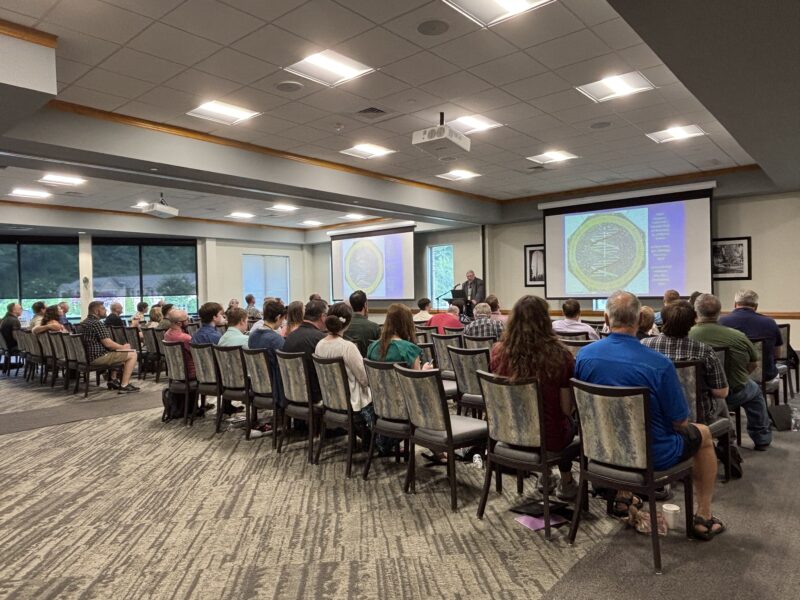










Will the videos from this be available to those who couldn’t attend?
Unfortunately, the lectures will not publicly released. I believe the abstracts will be probably be published early next year.
Hello Suzanne,
Unfortunately, the conference presentations were not recorded, so there won’t be official videos from the event itself. That said, several of the speakers have independently shared their talks or related content independently, such as…
Peter Brummel: Is Eridu the Biblical Babel?
Marcus Ross & Dustin Burlet: The Indominatables
Ken Coulson: Contextualizing Genesis 1:31’s “Very Good”
Zachary Klein: Ordovician Density Flow Complex
While not a complete list, I hope this points you in the right direction! 🙂
This was an amazing amount of information to learn about and process. I am very interested in all of it really. As a biology student, I am biased towards things like CODE and the tests on the possible orientation of the pre-flood continents, but I am also very interested in things like the critiques of DR. Petrovitch’s location for Babel, which has gone mostly unchallenged for a very long time. (Not to say Petrovitch hasn’t and doesn’t do good work. It’s just interesting to think about where this observation may lead creation archaeology) One of my favorites was also the findings of using ML in paleontology. It is very interesting to think about how paleogeography may be used in the future to build creation models. Perhaps it could open up new theories for pre-flood environments. It’s just so exciting to think about the next century of creationism! I hope I can be a part of it as well.